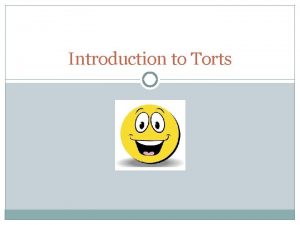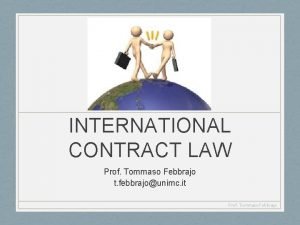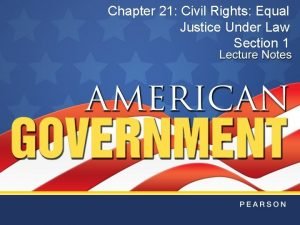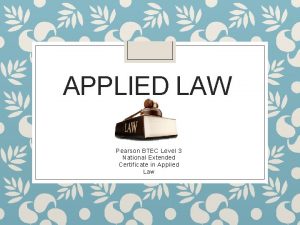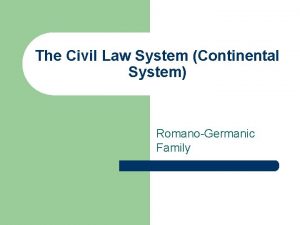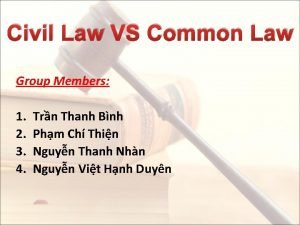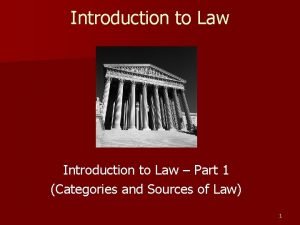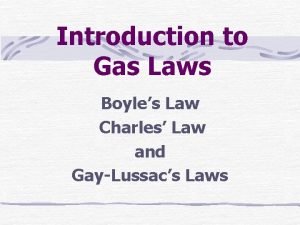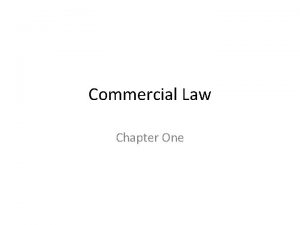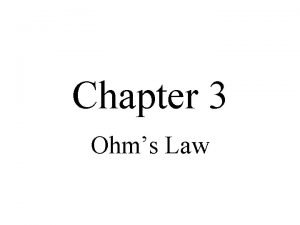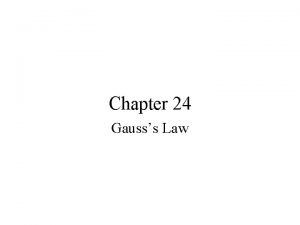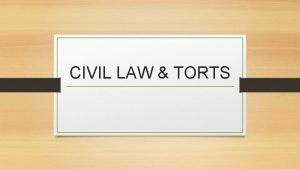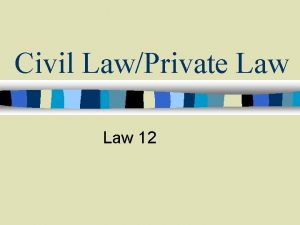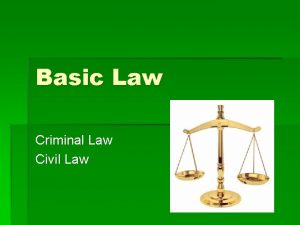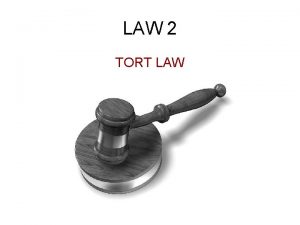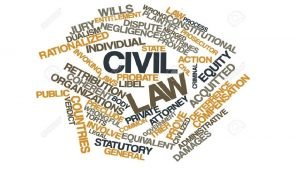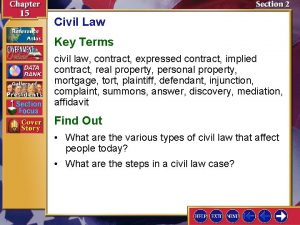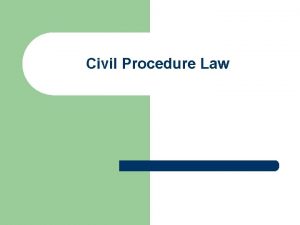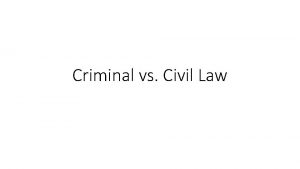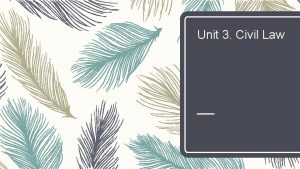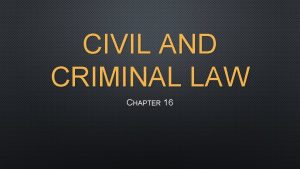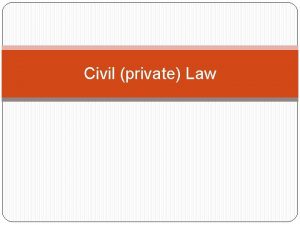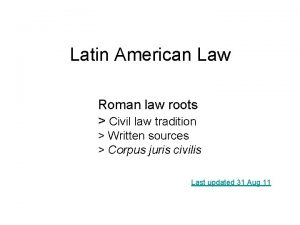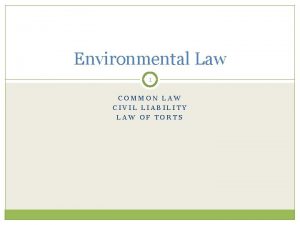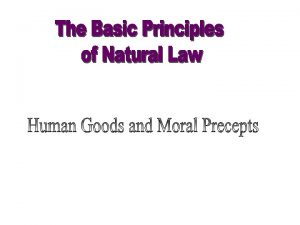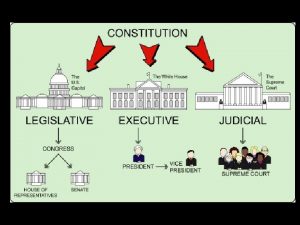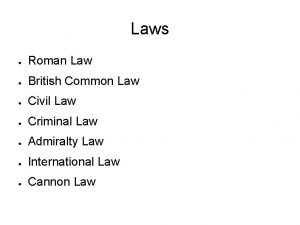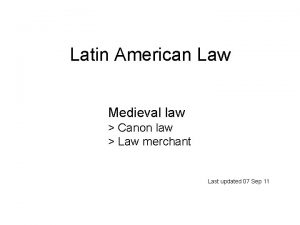90 Civil Law Introduction Civil Law Civil law



























- Slides: 27

90 Civil Law Introduction

Civil Law • Civil law, also known as private law or tort law, regulates disputes between individuals. • The main purpose of criminal law is to punish offenders while protecting society. • The main purpose of civil law is to compensate for harm, usually in 90 the form of damages - $$$ awarded to a plaintiff for harm, loss, or injury. • Plaintiff: the person or party that initiates the lawsuit. • Defendant: the party that must respond to the lawsuit. • Judge/Jury • Court Officers (clerk, sheriff, etc. )

Youth • A minor can not represent his or herself. • If suing, they must be represented by a next friend. • If they are being sued, they must have a guardian at litem, 90 which literally means, “a guardian for the suit or for the purposes of the suit” • The same holds true for those with disabilities.

Civil Actions • Typical civil actions, or lawsuits, fall under these categories: 1. Tort Law: injuries or harm created by one person to another’s body, reputation, or property; “tort” is derived from a Latin word meaning “twisted” or “wrong. ” Family Law: personal disputes that involve marriage, 90 adoption, and support claims. divorce, child custody, Contract Law: failing to fulfill the terms of an agreement, such as non-payment for a service. Labour Law: disputes in the workplace such as wrongful dismissal, unpaid overtime. Property Law: disputes about ownership or maintenance of property. 2. 3. 4. 5.

Crimes and Torts • Many crimes can also become torts. If a person is convicted of a crime, the victim does not usually gain from that personally. • In many cases, a person can be sued in addition to being charged. • Example: A person 90 who is charged with assault may also be sued by the victim for battery. If successful, the victim will receive compensation directly. • Other common examples include – the crime of break and enter = the tort of trespass to land – the crime of theft = the tort of trespass to goods.

Civil Courts • Civil actions can become very complex and almost always involve money. • Similar to criminal law, there are different types of civil courts used to hear various civil cases. • Cases that involve large sums of money are tried 90 in a provincial supreme court and may be appealed to a provincial appeal court. Some cases that require important precedents may go the Supreme Court of Canada. • Generally, cases that are relatively minor in nature are heard in small claims court.

Small Claims Court • Often referred to as “the people's court, ” small claims court resolves civil disputes of $10, 000 or less, although some provinces have limits as high as $25, 000. • The trial itself is more informal, with the plaintiff and defendant representing themselves. 90 • Both parties present their sides of the story to a judge and do not need to know much about the law as the dispute is usually fairly simple. • Plaintiffs file the paperwork themselves and pay a court fee. The defendant receives a copy of the lawsuit and then a court date is set.

Small Claims Actions • Common examples of small claims actions: – breach of contract – minor accidents – damage to property – recovery of property 90 – unpaid bills, loans, rent, or wages • The dollar limit for small claims court ranges from $5000 to $25, 000, depending on the province.

Balance of Probabilities • In a criminal case, verdicts are based on the concept of beyond a reasonable doubt. • In a civil case, verdicts are based on the balance of probabilities, which means “more probable than not. ” • The plaintiff and defendant, also known as the 90 litigants, must convince the judge that their version of the dispute is the correct one. • The judge must then decide which version or story is more believable. • If the plaintiff wins the case, the defendant is liable or responsible; if the defendant wins, he or she is not liable.

Stages in a Civil Action • 1. Cause of action – Why is the plaintiff suing? – Must file within 2 -5 years (depending) after the incident • 2. Writ of Summons or Statement of 90 Claim – Some provinces have courts that will issue a writ. This informs the defendant why they are being sued and asks for a response – Some provinces have plaintiffs complete a statement of claim, which outlines the facts supporting the civil action

Stages of a Civil Action. . . contd • 3. Statement of Defense – Sets out the defendant’s version of the facts – Has 10 -30 days to respond (depending on province – Defendant may deny liablity 90 a counterclaim, which is an – Defendant may file independent cause of action against the plaintiff – The amount suing for could be less, equal to, or greater than the plaintiff – Defendant can also make a third-party claim, and not only deny responsibility, but inform the court of who actually is liable (liable means legally responsible)

Stages of a Civil Action. . . contd • 4. Reply – The plaintiff has the opportunity to respond to the defendant’s statement of claim – New issues that may have arisen will be discussed 90 Discovery • 5. Examination for – Both litigants (plaintiff and defendant) are able to question each other, this is usually orally and recorded, so no surprises come up in court – The information obtained can be used at trial, and can contradict testimony if a party tells a different story at the trial

Stages of a Civil Action. . . contd • 6. Examination of Documents – Both sides must produce an Affidavit of Documents, which is a list of all documents that will be used as evidence in court – Failure to provide these will make the 90 documents inadmissible in court – Privileged Documents, such as those between lawyers and their clients, do not need to be produced • 7. Pretrial Conference – Litigants, their lawyers, and an unbiased judge sit down and try to come to a settlement before going to trial

LAST Stages of a Civil Action Settle out of Court • No defense, judge throws it out • Trivial or silly, judge throws it out • If both litigants can 90 agree, they can settle out of court • This is encouraged, and plaintiffs can be “punished” financially for not settling out of court or Trial Court • Usually Judge alone (If a jury, it is 6) • Plaintiff may have to pay a “security” to ensure that court costs will be paid if they lose, this prevents silly civil suits • Defendants who lose will usually pay the court costs • Cost can be a deterrence in civil court, its $$$$!

Yes, you can appeal • The party that appeals is the appellant • The party that responds is the respondent • Appeals can apply to mistake of facts by the judge 90 to mistake of the law • Appeals can apply by the judge • In some provinces, you can automatically appeal • In other provinces, or when applying to the Supreme Court, you need to ask for a “leave to appeal”

Class Action Suits • A class action lawsuit is a single legal action that is brought forward on behalf of several people who share a common grievance. • Example: In recent years, there have been a number of lawsuits against drug manufacturers by people who claim to have suffered side 90 overdoses to illness. effects ranging from • In this kind of situation, all the people who have suffered from a particular drug can sue the drug manufacturer together and can all be named as plaintiffs. • Class action suits put more pressure on defendants and, if successful, often result in higher settlements.

Remedies • In private law, compensation is usually provided in the form of damages. There are various types of damages, including: 1. 2. 3. 4. 5. General Special Punitive Aggravated Nominal 90

General Damages • This type of damages cannot be easily or precisely calculated and can be divided into pecuniary and non-pecuniary. • Pecuniary damages: 90 loss of income, future earnings, and cost of specialized future care • Non-pecuniary damages: money awarded for pain and suffering and loss of enjoyment of life (much harder to calculate) • The term pecuniary means “related to money. ”

Special & Punitive Damages Special Damages • This type of damages is awarded for specific outof-pocket expenses incurred before the trial. • These include hospital costs and therapy. 90 Punitive Damages • This type of damages is meant to punish the defendant for what is considered to be malicious behaviour. • If the defendant has already been convicted in criminal court for the offence, punitive damages are not usually awarded.

Aggravated & Nominal Damages • • Aggravated Damages This type of damages is awarded for mental distress and humiliation, or pain and suffering. In Canada, there are limits to how much money a person can receive for pain and suffering. Multi-million dollar lawsuits are more common in the United States. 90 Nominal Damages This type of damages is awarded as a moral victory for the plaintiff. In these cases, the plaintiff has suffered little or no harm, but the judge agrees with his or her reasons for bringing the lawsuit forward.

Injunctions • An injunction is a court order that directs a person to do something OR avoid doing something for a specific period of time and can be issued as a type of civil remedy. • If ordered to do something, it is a mandatory injunction 90 • If ordered to stop doing something, it is a prohibitory injunction • If a person served with an injunction fails to obey it, he or she may be found in contempt of court and receive a fine or jail sentence. • Examples include staying away from a certain person or limiting certain types of behaviour, such as spilling oil into a lake

Contingency Fees • A contingency fee is an arrangement between a lawyer and a client regarding payment. • Lawyers agree to be paid a certain agreed-upon percentage at the end of the trial or settlement but do not receive money otherwise. • Contingency fees 90 are common in class action lawsuits or if a person cannot afford a lawyer. • The risk for lawyers is if they do not gain the verdict, they will not receive money for their services—but if they do win, they usually make more money than their standard fees.

Enforcing Judgments • When a plaintiff wins a case, it is the plaintiff’s responsibility to collect any damages awarded from the defendant, who must cooperate. • In order for a plaintiff to successfully claim his or her damages, a defendant’s ability to pay is analyzed. This is known as the examination of the debtor. • A defendant must have: – money 90 for money – assets that can be sold – money owed to them that can be redirected to the plaintiff • A defendant may also have his or her wages garnished— a percentage of the defendant’s income is directed at paying the damages, similar to repaying a loan. • If a defendant’s wages are garnished, the court must leave him or her with enough money to live on and provide for any dependants he or she may have. • As a last resort, a sheriff can seize assets of the debtor, with a writ of execution, but they must prove the stuff belongs to the debtor!

Alternative Sources of Compensation • 1. Motor Vehicle Liability Insurance – When motor vehicle claims are issued, the insurance company will pay • 2. No-Fault Motor Vehicle Insurance – This insurance system provides money to victims across Canada without having to show who is at fault, since civil suits can take years 90 • 3. Worker’s Compensation – If you pay into this fund at your job, and you are hurt on the job (whether it was your fault or not), this fund will pay for your medical bills, lost wages, etc. It will not pay for “pain and suffering” though • 4. Criminal Injuries Compensation – This fund provides money to people who fall victim of violent crimes, when the assailant has no assets or insurance – Must prove you were completely innocent, and had no part in any part of the crime

Alternative Dispute Resolution • Also known as ADR, alternative dispute resolution is designed to solve civil disputes without having a formal trial. • Advantages to ADR include: – – It is less expensive and faster than going to court. It usually creates less 90 stress on the parties involved. It may result in a better or fairer resolution. It often results in an acceptable compromise that benefits both parties while avoiding the animosity of going to court. • There are three basic ADR models: negotiation, mediation, and arbitration.

ADR Models Negotiation: the parties involved try to resolve their dispute directly, with or without lawyers. Mediation: a neutral third party is brought in to help the parties resolve their dispute; a mediator 90 has no actual decision-making power. -success rate in Canada is 80 -85% Arbitration: a neutral third party is brought in to decide the case; an arbitrator’s decisions are binding and final.

ADR Cons • What are the negatives to seeking alternative dispute resolution? 90
 Difference between civil law and criminal law
Difference between civil law and criminal law Difference between civil law and criminal law
Difference between civil law and criminal law Common law and civil law
Common law and civil law Common law and civil law
Common law and civil law Tommaso febbrajo
Tommaso febbrajo Civil rights and civil liberties webquest
Civil rights and civil liberties webquest Introduction to civil engineering
Introduction to civil engineering Newton's first law and second law and third law
Newton's first law and second law and third law Newton's first law and second law and third law
Newton's first law and second law and third law Boyle's law charles law avogadro's law
Boyle's law charles law avogadro's law Constant in avogadro's law
Constant in avogadro's law Chapter 21 civil rights equal justice under law
Chapter 21 civil rights equal justice under law 1453-395
1453-395 Pearson applied law past papers
Pearson applied law past papers Florida civil law notary
Florida civil law notary Roman law
Roman law Continental law
Continental law Difference between civil and criminal law table
Difference between civil and criminal law table Sources of civil law
Sources of civil law Difference between civil and criminal law table
Difference between civil and criminal law table Civil law
Civil law Vauxhall estates v liverpool corporation
Vauxhall estates v liverpool corporation Body paragraph structure
Body paragraph structure Introduction of boyle's law
Introduction of boyle's law Introduction of commercial law
Introduction of commercial law Ohms law introduction
Ohms law introduction Gauss law is dependent on internal charge configuration
Gauss law is dependent on internal charge configuration Forensic science chapter 1
Forensic science chapter 1

